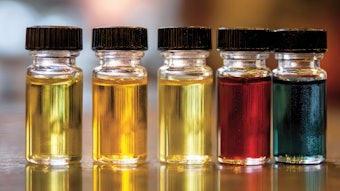Vetiver (Chrysopogon zizanioides) is a perennial grass of the Poaceae family, native to India. Although it originates in India, vetiver is widely cultivated in the tropical regions around the world. The world’s major producers include Haiti, India, Indonesia’s Java and the French island Réunion.
α-Vetivone (CAS# 15764-04-2; (4R,4aS)-4,4a-dimethyl-6-propan-2-ylidene-4,5,7,8-tetrahydro-3H-naphthalen-2-one) has a warm pleasant powerful odor while β-vetivone (CAS# 18444-79-6; (5R,10R)-6,10-dimethyl-2-(1-methyl-ethylidene)-spiro[4.5]dec-6-en-8-one) has a quinolinelike, fruity (cassis, grapefruit) aroma with a woody by-note.
Vetiver oil is steam distilled from cleaned and washed rootlets, which are dried, cut and chopped, and then usually soaked in water again prior to distillation. The distillation is undertaken near the place of harvesting with the exception of small lots, which are distilled in Europe or the United States from rootlets that have been imported from India, Indonesia or other places. Vetiver oil is an amber to grayish brown, olive brown or dark brown viscous liquid with an odor that is sweet and very heavy woody-earthy, reminiscent of roots and wet soil, with a rich undertone of precious wood notes. Oils distilled from too young rootlets and very freshly distilled oils may display some green, potato peel or asparaguslike top notes. The green note might come from 2-methoxy-3-isopropylpyrazine (FEMA# 3358, CAS# 25773-40-4; F-3), or other pyrazines that have been identified in vetiver oil.1, 2










